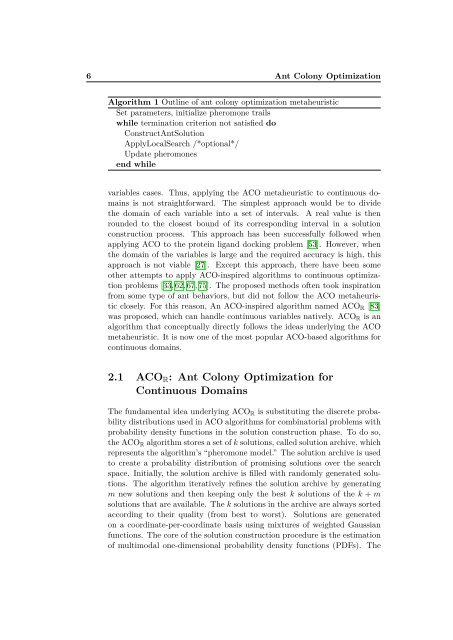Improved ant colony optimization algorithms for continuous ... - CoDE
Improved ant colony optimization algorithms for continuous ... - CoDE
Improved ant colony optimization algorithms for continuous ... - CoDE
Create successful ePaper yourself
Turn your PDF publications into a flip-book with our unique Google optimized e-Paper software.
6 Ant Colony Optimization<br />
Algorithm 1 Outline of <strong>ant</strong> <strong>colony</strong> <strong>optimization</strong> metaheuristic<br />
Set parameters, initialize pheromone trails<br />
while termination criterion not satisfied do<br />
ConstructAntSolution<br />
ApplyLocalSearch /*optional*/<br />
Update pheromones<br />
end while<br />
variables cases. Thus, applying the ACO metaheuristic to <strong>continuous</strong> domains<br />
is not straight<strong>for</strong>ward. The simplest approach would be to divide<br />
the domain of each variable into a set of intervals. A real value is then<br />
rounded to the closest bound of its corresponding interval in a solution<br />
construction process. This approach has been successfully followed when<br />
applying ACO to the protein ligand docking problem [53]. However, when<br />
the domain of the variables is large and the required accuracy is high, this<br />
approach is not viable [27]. Except this approach, there have been some<br />
other attempts to apply ACO-inspired <strong>algorithms</strong> to <strong>continuous</strong> <strong>optimization</strong><br />
problems [33, 62, 67, 75]. The proposed methods often took inspiration<br />
from some type of <strong>ant</strong> behaviors, but did not follow the ACO metaheuristic<br />
closely. For this reason, An ACO-inspired algorithm named ACOR [83]<br />
was proposed, which can handle <strong>continuous</strong> variables natively. ACOR is an<br />
algorithm that conceptually directly follows the ideas underlying the ACO<br />
metaheuristic. It is now one of the most popular ACO-based <strong>algorithms</strong> <strong>for</strong><br />
<strong>continuous</strong> domains.<br />
2.1 ACOR: Ant Colony Optimization <strong>for</strong><br />
Continuous Domains<br />
The fundamental idea underlying ACOR is substituting the discrete probability<br />
distributions used in ACO <strong>algorithms</strong> <strong>for</strong> combinatorial problems with<br />
probability density functions in the solution construction phase. To do so,<br />
the ACOR algorithm stores a set of k solutions, called solution archive, which<br />
represents the algorithm’s “pheromone model.” The solution archive is used<br />
to create a probability distribution of promising solutions over the search<br />
space. Initially, the solution archive is filled with randomly generated solutions.<br />
The algorithm iteratively refines the solution archive by generating<br />
m new solutions and then keeping only the best k solutions of the k + m<br />
solutions that are available. The k solutions in the archive are always sorted<br />
according to their quality (from best to worst). Solutions are generated<br />
on a coordinate-per-coordinate basis using mixtures of weighted Gaussian<br />
functions. The core of the solution construction procedure is the estimation<br />
of multimodal one-dimensional probability density functions (PDFs). The

















